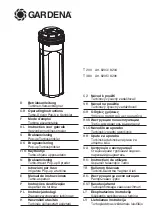
FOR MOBILE APPLICATIONS
W25Q256FV
Publication Release Date: May 13, 2012
- 50 - Preliminary - Revision M1
M7-0
/CS
CLK
8.2.20
Fast Read Quad I/O (EBh)
The Fast Read Quad I/O (EBh) instruction is similar to the Fast Read Dual I/O (BBh) instruction except
that address and data bits are input and output through four pins IO
0
, IO
1
, IO
2
and IO
3
and four Dummy
clocks are required in SPI mode prior to the data output. The Quad I/O dramatically reduces instruction
overhead allowing faster random access for code execution (XIP) directly from the Quad SPI. The Quad
Enable bit (QE) of Status Register-2 must be set to enable the Fast Read Quad I/O Instruction.
Fast Read Quad I/O with “Continuous Read Mode”
The Fast Read Quad I/O instruction can further reduce instruction overhead through setting the
“Continuous Read Mode” bits (M7-0) after the input Address bits (A23/A31-0), as shown in Figure 24a.
The upper nibble of the (M7-4) controls the length of the next Fast Read Quad I/O instruction through the
inclusion or exclusion of the first byte instruction code. The lower nibble bits of the (M3-0) are don’t care
(“x”). However, the IO pins should be high-impedance prior to the falling edge of the first data out clock.
If the “Continuous Read Mode” bits M5-4 = (1,0), then the next Fast Read Quad I/O instruction (after /CS
is raised and then lowered) does not require the EBh instruction code, as shown in Figure 24b. This
reduces the instruction sequence by eight clocks and allows the Read address to be immediately entered
after /CS is asserted low. If the “Continuous Read Mode” bits M5-4 do not equal to (1,0), the next
instruction (after /CS is raised and then lowered) requires the first byte instruction code, thus returning to
normal operation. It is recommended to input FFh/3FFh on IO0 for the next instruction (8/10 clocks), to
ensure M4 = 1 and return the device to normal operation.
Figure 24a. Fast Read Quad I/O Instruction (Initial instruction or previous M5-4
≠
10, SPI Mode)
32-Bit Address is required when the device is operating in 4-Byte Address Mode
Mode 0
Mode 3
0
1
IO
0
IO
1
IO
2
IO
3
2
3
4
5
20
16
12
8
21
17
22
18
23
19
13
9
14
10
15
11
A23-16
6
7
8
9
4
0
5
1
6
2
7
3
A15-8
A7-0
Byte 1
Byte 2
4
0
5
1
6
2
7
3
4
0
5
1
6
2
7
3
4
0
5
1
6
2
7
3
10
11
12
13
14
4
5
6
7
15
IOs switch from
Input to Output
Byte 3
16
17
18
19
20
21
22
23
Dummy
Dummy
Instruction (EBh)
















































